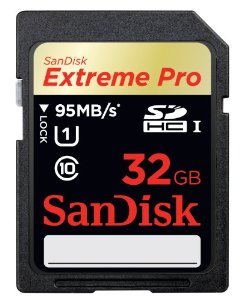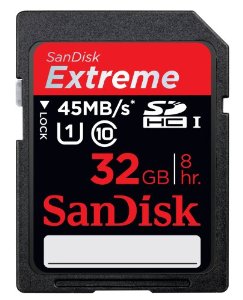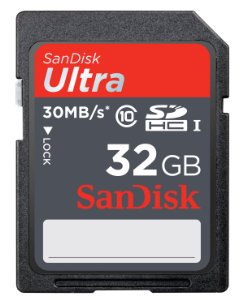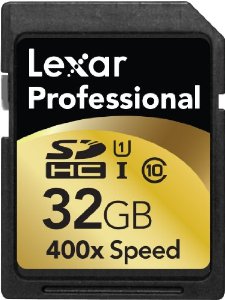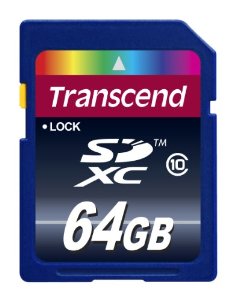- Forum
- Photography and Camera Forum
- Equipment Research, Buying and Using
- Computers
- Memory Card Buying Guide: Know what do you look for BEFORE buying!
Memory Card Buying Guide: Know what do you look for BEFORE buying!
-
 Topic Author
Topic Author
- PhotographyTalk
- Master of the Lens
- Followers: 270
- Posts: 1638
-
Points:
484
Post #274113
• The level of your DSLR.
• What kind of photography you like to shoot.
• The conditions under which you shoot.
• How many images you capture during a session.
• Whether they are RAW or JPEG.
• The speed of your camera’s continuous burst mode and whether you use it at its fastest speed.
• How quickly you want images to be read for transfer to your computer and write speed for continuous burst mode, HD video and 3D video.
1. SanDisk Extreme Pro Memory Cards
Since I shoot with the Nikon D800, I rely on SanDisk memory cards , especially the Extreme Pro cards because they read as fast as 95MB per second and write at 90MB per second. They are also rated at UHS Speed Class 1 and Class 10 for Full HD and 3D video. Of course, factors, such as your camera model, file size, resolution, compression, bit rate, content, etc., will affect how well the SanDisk Extreme Pro memory cards support video.
Landscapes are probably my favorite photographic genre, so the Extreme Pro cards are also my choice because they’re engineered and built for extreme weather and other unknown conditions that you and I might face. For example, the SanDisk Extreme Pro cards are waterproof. They can be immersed in salt or fresh water for as much as 72 hours and to a depth of a bit more than 3 feet (1 meter). They can also withstand as much as 500Gs of shock and are vibration proof. Of extreme importance to photographers that travel often is that these cards are magnet proof and X-ray proof, protecting them from the scans of security machines at airports.
Another important reason I shoot with the SanDisk Extreme Pro Memory Cards is that one weekend I may be shooting in the hotter temperatures of the Pacific coast or inland desert, and then the next weekend shooting landscapes in the cold mountains. These cards are rated for -13 to 185 degrees Fahrenheit, so I know temperature will never be an obstacle.
The SanDisk Extreme Pro Memory Cards come in 8GB, 16GB , 32GB and 64GB capacities .
2. SanDisk Extreme Memory Cards
The only real difference between the SanDisk Extreme Pro and Extreme is the read/write rates. The Extremes have a 45MB rate. In addition, they are also available in more sizes: 4GB, 8GB, 16 GB, 32GB, 64GB and 128GB. Either card or size will work fine for any professional or serious amateur shooting with a pro-level DSLR.
3. SanDisk Ultra Memory Cards
SanDisk’s Ultra brand of memory cards is generally suited for mid-level DSLRs. If you are shooting with an entry-level camera, you may prefer the Ultra’s read/write rates to the company’s Standard line of cards that also work in entry-level DSLRs.
4. Lexar Memory Cards
Lexar is a brand that seems to receive good reviews and positive customer feedback. The Lexar Professional Class 10 UHS-1 card is available as an SDHC or SDXC type. The 600x is the equivalent of 90MB/second read transfer speed while the 400x is 60MB/second. Both are available at 64GB, 128GB and a whopping 256GB. The mid-level line of Lexar memory cards is known as Platinum II, with a slower, but still effective 200x speed, or 30MB/second. These are better for low-end DSLRs. The SDHC version is comes in 8GB, 16GB and 32GB. The SDXC Platinum II is only available with 64GB capacity.
5. Transcend Memory Cards
These are definitely budget-priced cards with slower transfer rates (20GB/18GB/second) than SanDisks or Lexars, but there is a wide range of capacities, from 8GB to 128GB. Enthusiasts and hobbyists shooting with equally budget-friendly DSLRs will find these cards do a good job. Professionals and serious amateurs with higher-grade DSLRs would probably find them too slow, especially if they shoot plenty of RAW files.
When choosing a memory card for your DSLR, remember to check your camera manual or with the manufacturer as to what card it recommends. Ultimately, the best card is the one that matches your camera. Many photographers have discovered they bought an incompatible card simply because they didn’t spend a few minutes doing some research. You’ll spend much more time fuming and cussing, calling the company’s tech support, repackaging the wrong card and returning it.
Recommended Reading:
- Best Business Practices for Photographers
- The Fast Track Photographer Business Plan: Build a Successful Photography Venture from the Ground Up
- Get Your Photography on the Web: The Fastest, Easiest Way to Show and Sell Your Work
- Selling Your Photography: How to Make Money in New and Traditional Markets
- Licensing Photography
- Starting Your Career as a Freelance Photographer
- Photographer's Survival Manual: A Legal Guide for Artists in the Digital Age
- Legal Handbook for Photographers: The Rights and Liabilities of Making Images
- Business and Legal Forms for Photographers
-

- Julie Staas
- Lone Wolf
-
- Nikon D300
- Followers: 44
- Posts: 236
-
Points:
889
Post #274362
Country Girl out for a stroll
-

- ubix22
- Newbie
- Follower: 1
- Posts: 1
-
Points:
10
Post #280322
-
 Pt+
Pt+ - Pilotshark
- Photography Hooked
-
- Samsung Galaxy S 10+ and camera on my Mavic Air 2 drone.
- Followers: 84
- Posts: 962
-
Points:
17940
Post #708171
Sandisk is the way to go No Muss or Fuss just put it in and shoot.
So after so many years of doing this or that and life itself getting in my way, I am now at the point where just slowing down and doing things I have put off I have concluded that its time to become creative and do what I want.
Thanks for giving me a place to get started.
-

- Piechura
- Newbie
- Followers: 7
-
Points:
5583
-

- Screamin Scott
- Moderator
-
- Nikon D610, Nikon D7100, Nikon D300, Olympus OMD E-M5 MarkII, Olympus OM-D E-M10, Olympus Pen E-P3 + film SLR's
- Followers: 1384
- Posts: 6866
-
Points:
40251
Post #708181
- Forum
- Photography and Camera Forum
- Equipment Research, Buying and Using
- Computers
- Memory Card Buying Guide: Know what do you look for BEFORE buying!
Latest Reviews
The Olympus Pen E-P7 is an affordable micro four thirds mirrorless camera with 4K video capabilities, a 20.3MP sensor, and 121 focus points, making it a solid entry-level camera for beginners.
The Panasonic G9 II is a 25.2-megapixel micro four thirds camera with numerous features that make it punch out of its weight class, like 779 AF points, 5.8K video, and weather sealing.
The Fujifilm XT5 is a 40MP mirrorless camera capable of 6.2K video at 30p. With those specs, it’s an ideal choice for photographers needing a camera to pull double duty for imaging and video.
The Canon EOS R100 is an entry-level mirrorless camera introduced in 2023. But just because it’s an entry-level camera doesn’t mean it’s a bare-bones camera. Find out why in this review!
Latest Articles
In this guide to the bokeh effect, you’ll learn what bokeh is and the factors involved in creating it. You’ll also explore some beautiful example images to spark your creativity with bokeh!
Upgrade your kit in 2024 with the best intermediate camera on the market! The question is, what camera fits the bill? We’ve got three top options for you to choose from in this buyer’s guide.
The best photography jobs right now are a mix of tried-and-true gigs like wedding photography and new jobs highlighting AI’s capabilities, travel, and videography.
The Olympus Pen E-P7 is an affordable micro four thirds mirrorless camera with 4K video capabilities, a 20.3MP sensor, and 121 focus points, making it a solid entry-level camera for beginners.
Starting a photography business is one thing; sustaining your business over a long period of time is another. Use the tips in this professional photography guide to build something with longevity!
The Panasonic G9 II is a 25.2-megapixel micro four thirds camera with numerous features that make it punch out of its weight class, like 779 AF points, 5.8K video, and weather sealing.
Cinematic photography is an interesting genre that combines photographic and videographic skills along with effective storytelling techniques. The result? Highly impactful images!
Newborn photography requires skill, the right gear, and a lot of patience. This beginner’s guide discusses critical topics that will help you be more prepared for before, during, and after the shoot.







